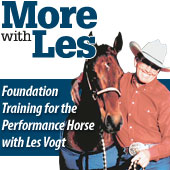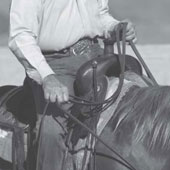
 Ninth in a series
Ninth in a series
Last issue, Les started an in-depth look at how to use our hands. We pick up with more keys to communication.
Another thing you’ll need to work on is to develop your hands’ “neutral” position, which needs to become one where there is no contact with the bit. Our goal is to have a horse that yields quickly and smoothly to any pressure – ideally to just the feel of you taking the slack out of the reins – and if you’re used to having contact with the bit all the time, you’ll never get there.
You may find yourself tempted to “hold” your horse into position once he’s accomplished something, but this is only going to lead to stiffness on the part of you and your horse. You’re going to have to learn to show him where you want him, and then make it his responsibility to continue until you tell him to stop. Let him make mistakes, then put him back on track and start again. This concept will apply to collection, circles, turnarounds – virtually every part of your training. Basically, it’s what “training” is all about – conditioning your horse until he does what you want – on his own – with virtually no help from you! Even as you’re working on keeping your horse in a collected frame, you won’t work to hold him there as much as to establish limits that he needs to stay within. If his nose stretches out enough that he takes the slack out of the reins, you’ll start working them again until he’s back where you want him and then turn him loose again.
Hand Position
Just as you want there to be some slack in your reins in your “neutral” position, there’s an area where you’re going to want your hands to be when they’re in “neutral” too, and that should be an area that’s as wide or wider than your shoulders, and above and in front of your saddle horn. If your reins are too long you’re going to be kind of helpless a lot of the time. So if your reins aren’t out in front of you like you’re riding a bicycle, they’re too long. Although your hands will move from this position at times as we work through different exercises, it’s good to always take them back to “neutral” when you’re done.
Throughout this program we are going to be encouraging our horses to carry their heads low, and the best way to do this is by keeping your hands low. Granted, at some point you’re going to move to one hand above the horse’s neck, but by that point your horse’s posture should be well established and your actual contact with the bit minimal.
Using Your Reins
In a right turn our right rein is our direct rein and the left rein, or outside rein, is called the indirect or neck rein, or sometimes the brace rein. The direct rein’s main function is to initiate direction by bending your horse’s head and neck the way you want to go. The indirect rein’s first function is forward and back. With slack the horse goes forward into the turn, but as I tighten my indirect rein, I can collect the horse and draw him backward with the same arc or posture that he had going forward. So if I was turning my horse and I wanted to tighten him up into a smaller circle or spin, I could draw that indirect rein back and help him to start moving laterally. The other function of the indirect rein is to move shoulders laterally, and we’ll spend a lot of time with that in exercise number two.
EDITOR’S NOTE: More with Les is a regular California Horsetrader column. Les Vogt has won more than 15 World Championships, including two wins at the NRCHA Snaffle Bit Futurity. Although Les still rides and occasionally shows, his focus is giving clinics around the world and developing products for the performance horseman. To learn more about Les and to see his clinic schedule, visit: www.lesvogt.com
Leave a Comment
All fields must be filled in to leave a message.